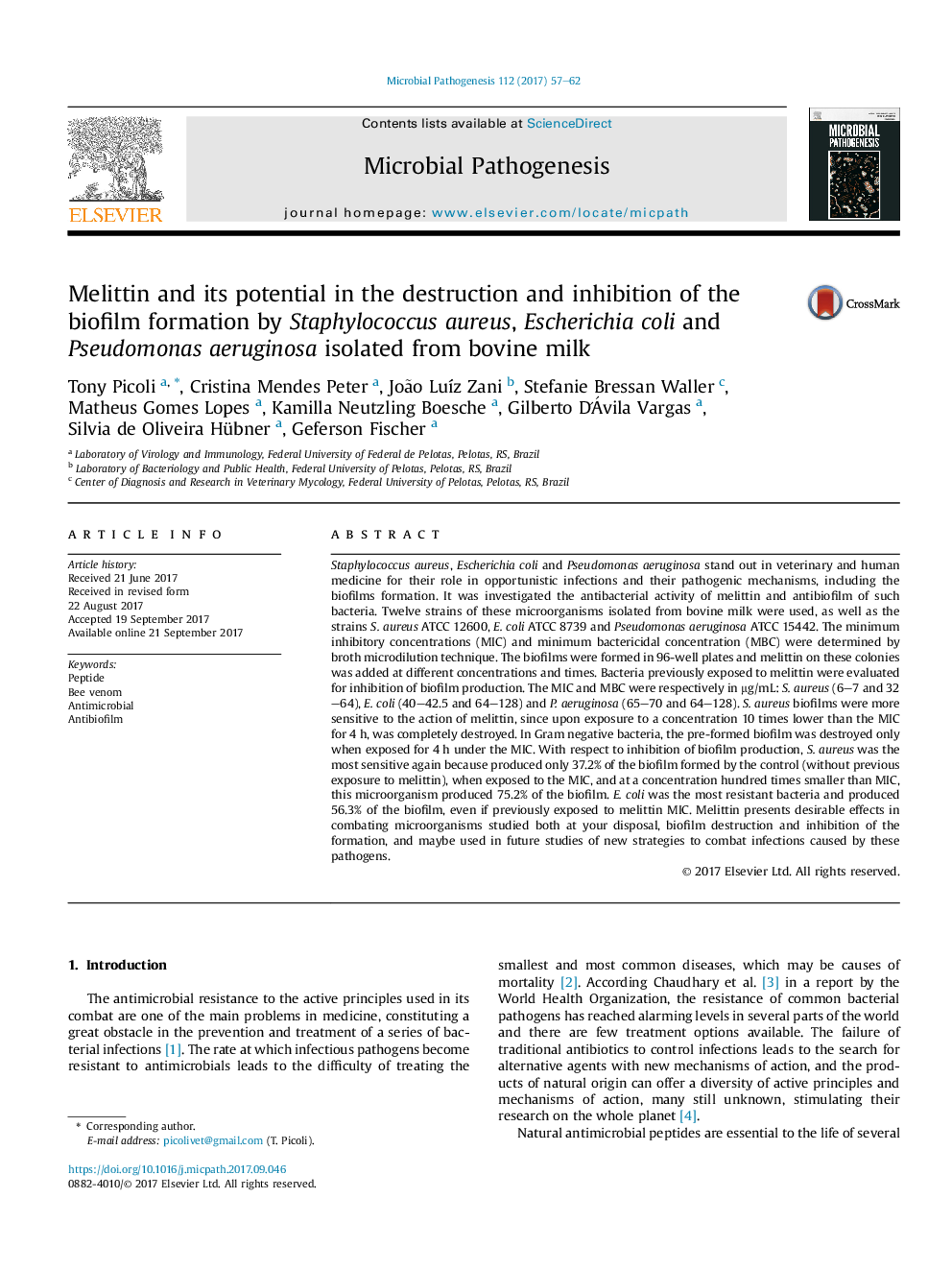| کد مقاله | کد نشریه | سال انتشار | مقاله انگلیسی | نسخه تمام متن |
|---|---|---|---|---|
| 5673505 | 1593677 | 2017 | 6 صفحه PDF | دانلود رایگان |
عنوان انگلیسی مقاله ISI
Melittin and its potential in the destruction and inhibition of the biofilm formation by Staphylococcus aureus, Escherichia coli and Pseudomonas aeruginosa isolated from bovine milk
ترجمه فارسی عنوان
ملتیتین و پتانسیل آن در تخریب و مهار تولید بیوفیلم توسط استافیلوکوک اورئوس، اشرشیاکلی و سودوموناس آئروژینوزا جدا شده از شیر گاو
دانلود مقاله + سفارش ترجمه
دانلود مقاله ISI انگلیسی
رایگان برای ایرانیان
کلمات کلیدی
پپتیده زهر زنبور عسل، ضد میکروبی آنتی بیوفیلم،
موضوعات مرتبط
علوم زیستی و بیوفناوری
ایمنی شناسی و میکروب شناسی
میکروب شناسی
چکیده انگلیسی
Staphylococcus aureus, Escherichia coli and Pseudomonas aeruginosa stand out in veterinary and human medicine for their role in opportunistic infections and their pathogenic mechanisms, including the biofilms formation. It was investigated the antibacterial activity of melittin and antibiofilm of such bacteria. Twelve strains of these microorganisms isolated from bovine milk were used, as well as the strains S. aureus ATCC 12600, E. coli ATCC 8739 and Pseudomonas aeruginosa ATCC 15442. The minimum inhibitory concentrations (MIC) and minimum bactericidal concentration (MBC) were determined by broth microdilution technique. The biofilms were formed in 96-well plates and melittin on these colonies was added at different concentrations and times. Bacteria previously exposed to melittin were evaluated for inhibition of biofilm production. The MIC and MBC were respectively in μg/mL: S. aureus (6-7 and 32-64), E. coli (40-42.5 and 64-128) and P. aeruginosa (65-70 and 64-128). S. aureus biofilms were more sensitive to the action of melittin, since upon exposure to a concentration 10 times lower than the MIC for 4 h, was completely destroyed. In Gram negative bacteria, the pre-formed biofilm was destroyed only when exposed for 4 h under the MIC. With respect to inhibition of biofilm production, S. aureus was the most sensitive again because produced only 37.2% of the biofilm formed by the control (without previous exposure to melittin), when exposed to the MIC, and at a concentration hundred times smaller than MIC, this microorganism produced 75.2% of the biofilm. E. coli was the most resistant bacteria and produced 56.3% of the biofilm, even if previously exposed to melittin MIC. Melittin presents desirable effects in combating microorganisms studied both at your disposal, biofilm destruction and inhibition of the formation, and maybe used in future studies of new strategies to combat infections caused by these pathogens.
ناشر
Database: Elsevier - ScienceDirect (ساینس دایرکت)
Journal: Microbial Pathogenesis - Volume 112, November 2017, Pages 57-62
Journal: Microbial Pathogenesis - Volume 112, November 2017, Pages 57-62
نویسندگان
Tony Picoli, Cristina Mendes Peter, João LuÃz Zani, Stefanie Bressan Waller, Matheus Gomes Lopes, Kamilla Neutzling Boesche, Gilberto D´Ávila Vargas, Silvia de Oliveira Hübner, Geferson Fischer,
